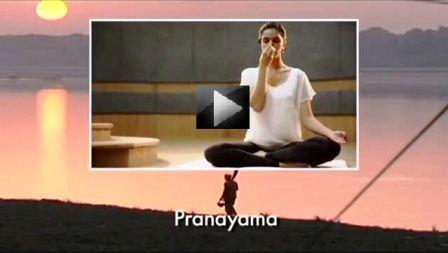Pranayama
Pranayama
Nadisodhana or Anuloma Viloma Pranayama (Alternate Nostril Breathing)
The main characteristic feature of this prāṇāyāma is alternate breathing through the left and right nostrils without or with retention of breath (kumbhaka).
Sthiti:Any meditative posture.
Technique
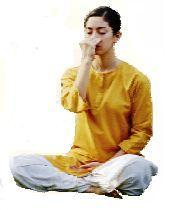 Sit in any meditative posture.
Sit in any meditative posture.- Keep the spine and head straight with eyes closed.
- IRelax the body with few deep breaths.
- Keep the left palm on the left knee in Jnāna mudra. The right hand should be in Nasagra mudra.
- Place the ring and small fingers on the left nostril; fold the middle and index finger. Place the right thumb on the right nostril;
- Breathe in from the left nostril; then close the left nostril with the small and ring fingers and release the thumb from the right nostril; exhale through the right nostril.
- Next, inhale through the right nostril.
- At the end of inhalation, close the right nostril, open the left nostril and exhale through it.
- This complete process is one round of the Nadisodhana or Anuloma Viloma Praṇayama
- Repeat 5 more rounds.
Ratio and timing:
- For beginners, the duration of inhalation and exhalation should be equal.
- Gradually make 1:2; inhalation: exhalation
Breathing :
- Breath should be slow, steady and controlled. It should not be forced or restricted in any way.
Benefits
- The main purpose of this praṇayama is to purify the principle channels of carrying energy called naid's; hence nourishes the whole body.
- Induces tranquility and helps to improve concentration
- Increases vitality and lowers the level of stress and anxiety
- It elevates cough disorders.
Śītalī Prānāyāma
Śītalī means cooling. It also means calm and passionless. As the name indicates this prānāyāma cools the mind-body system. It is specially designed to reduce the body temperature. Practice of this pranayama not only cools the physical body but also calms the mind.
Technique
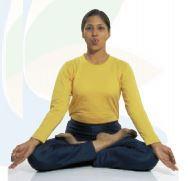 Sit in Padmasana or any other comfortable sitting posture.
Sit in Padmasana or any other comfortable sitting posture.- Place the hand on the knees in Jnanamudra or anjalimudra.
- Roll the tongue from the sides to shape as a tube
- Inhale through this tube shaped tongue, fill the lungs with air to their maximum capacity and close the mouth.
- Hold jalandhara bandh.
- Retain the air as long as one can maintain jalandharbandh.
- Release jalandharabandh and then slowly exhale through the nostrils.
Benefits
- Sitali pranayama purifies blood
- It has cooling effect on body
- It is beneficial for persons suffering from high blood pressure.
- It satisfies thirst and appeases hunger
- It relieves indigestion and disorders caused by phlegm (cough) and bile (pitta)
- It destroys the disorders of gulma (chronic dyspepsia) and spleen or other related diseases (H.P 2/58).
- It is beneficial for skin and eyes.
A word of caution
- Those who are suffering from cold, cough or tonsillitis should not do this Pranayama.
Bhramari Pranayama (Bhramari Recaka)
Bhrāmarī is derived from bhramara which means a black bee. During the practice of this prānāyāma, the sound produced resembles the buzzing of a black bee.
Sthiti: Any meditative posture.
Technique Type:I
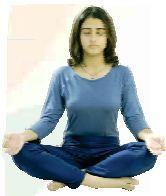 Sit in any meditative posture with eyes closed.
Sit in any meditative posture with eyes closed.- Inhale deeply through the nose.
- Exhale slowly in a controlled manner while making a deep, steady humming sound such as that of black bee. This is one round of Bhramari.
- Repeat 5 rounds.
Technique Type :II
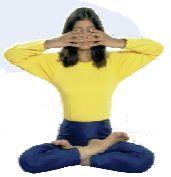 Sit in any meditative posture with eyes closed.
Sit in any meditative posture with eyes closed.- Inhale deeply through the nose.
- Close the eyes with index fingers, mouth with ring and small fingers and ears from respective thumbs as shown in the figure. This is also called Sanmukhi Mudra.
- Exhale slowly in a controlled manner while making a deep, steady humming sound such as that of black bee. This is one round of Bhramari.
- Repeat 5 more rounds.
Benefits:
- The practice of Bhrāmarī relives stress and helps in alleviating anxiety, anger and hyperactivity.
- The resonance effect of humming sound creates a soothing effect on the mind and nervous system.
- It is a great tranquiliser; found good in the management of stress related disorders.
- It is a useful preparatory pranayama for concentration and meditation.
A word of caution: Please avoid this practice in case of nose and ear infections.
Source: Ministry of AYUSH
Last Modified : 6/21/2022
This topic provides information about Pranayama fo...
This topic provides information about The Role of ...
This topic provides information about Desktop Yoga...
This topic provides information about Managing Pep...
